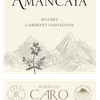The success of the first vintages of CARO encouraged Domaines Barons de Rothschild Lafite and the Catena family to create another premium wine, this time a Malbec dominated cuvée, that would nevertheless be a balance between the Bordeaux and Argentine styles. To celebrate its Andean origin, the wine was named Amancaya, after the mountain flower which grows in the Andes.
- About Us
- Producers
-
Wines
add
Countries
-
Spirits
add
CountriesAwards
- Where to Buy
- PBI Journal
- Contact Us














